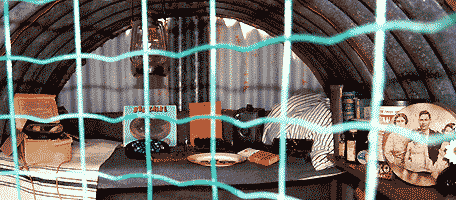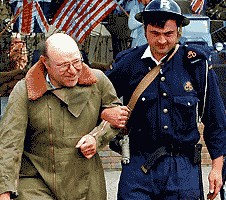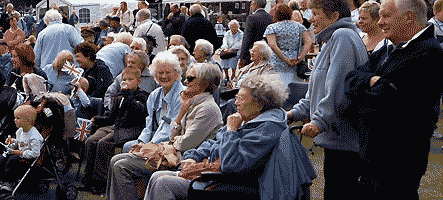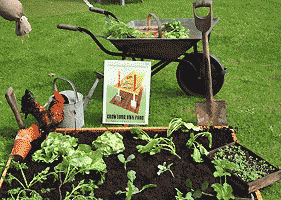|
Hellfire Corner Association
1940s WEEKEND

"Land of Hope and Glory" - on 16th and 17th June 2007 Pencester
Gardens, Dover, hosted the third 1940s weekend, arranged by the
Hellfire Corner Association. With re-enactors and living history
groups, specialist researchers and entertainers, and a 1940s
dance in the evening at the Town Hall, it was a weekend
not to miss! And thousands
of visitors agreed.
For all of us who were there, here's a chance to enjoy it all
again. For those who weren't - don't miss it next year!

The weekend was opened by our very own Bob Markham, Mayor of
Dover. He then used one of the old-time
 sirens
to sound the all clear for ... a lot of fun! sirens
to sound the all clear for ... a lot of fun!
Here's our Master of Ceremonies, one Terry Nunn. What have
you done with Chesney, Terry?
Terry tells us that, despite all our suspicions, his
magnificent bow tie doesn't revolve and flash, so ...with the
event well and truly open, let's wander around, and see what's
on.
Here's one of the displays, from Gary and Cheryl Patten. A lot
of Dovorians remember the Anderson shelter - and there are still
quite a few in Dover.
 Nowadays,
though, they're used for more peaceful pursuits, like storing
the garden tools. This glimpse inside shows some of the things
people might have grabbed when the sirens began to wail - a game
for the children, some cigarettes, the family picture. One lady
always seized the cat as she raced down the garden path, with
her children all running behind. Nowadays,
though, they're used for more peaceful pursuits, like storing
the garden tools. This glimpse inside shows some of the things
people might have grabbed when the sirens began to wail - a game
for the children, some cigarettes, the family picture. One lady
always seized the cat as she raced down the garden path, with
her children all running behind.

The shelters are small, about as long as a grown man, and were
partially buried in the ground. Earth would be heaped over them,
and in the spirit of utility and digging for victory, often
vegetables would be grown on the top. They had a small
entrance to crawl through, usually covered only with a blanket
and protected by the surrounds. This was less dangerous than a door
which could be shattered by a blast.

Here's the Women's Land Army. With most of the men off fighting,
and a great reliance pre-war on imported foods, Britain couldn't
have survived without the ladies working the farms. Disparaged
at first, u nder
the belief that they wouldn't be able to stack stooks and manage
machinery, they soon earned respect. nder
the belief that they wouldn't be able to stack stooks and manage
machinery, they soon earned respect.
Even so, it was only in 2000 that they marched past the Cenotaph
for the first time, and they have never been awarded medals for
their vital service.
Kay and Susan Brown are enjoying a well-earned break - but there
are other distractions on the horizon too. Not for the first
time, there's a GI chatting up one of our lasses! (It's okay,
it's her husband, Tony, also in costume!)


There were plenty of 1940s people to spot, mingling with the
crowds. They're from the re-enactors, "Don't Mention the War!"
and from the Kent Time Warp Car and Costume group, who also brought along their
classic and veteran vehicles.
This is a smart group on the left - I wonder where they're off
to?
And two ladies pause in their errands to enjoy a chat while all's well.
|
Even policeman Steven George has a few moments off
from his beat, to exchange the news with one of the
locals (Trevor Foster).

|
 |
 But Britain must always be on the alert, and especially in Hellfire Corner itself. Just up the road is the ARP
Post. Air Raid Precautions Wardens were organised in 1938.
Originally ridiculed for form-filling "nosiness", their extensive local knowledge soon
proved itself. Each in charge of a couple of streets, they knew
who lived in each house,
and where to turn off the water and electricity in case of
emergency. Above are ARP Warden Sean Couchman, and his later counterpart,
Graham Wood, from the Civil Defence, exchanging vital
information. But Britain must always be on the alert, and especially in Hellfire Corner itself. Just up the road is the ARP
Post. Air Raid Precautions Wardens were organised in 1938.
Originally ridiculed for form-filling "nosiness", their extensive local knowledge soon
proved itself. Each in charge of a couple of streets, they knew
who lived in each house,
and where to turn off the water and electricity in case of
emergency. Above are ARP Warden Sean Couchman, and his later counterpart,
Graham Wood, from the Civil Defence, exchanging vital
information.
It's just as well, too, because you never know when the call
will come. This poor pilot (left) has crash-landed from a
Hawker Hurricane, and he's clearly in need of some assistance.
 |
At least he's still walking - and here (left) is just the place to go. A
nice cup of tea and a bit of cake should soon put our pilot
right.
The big smile from Naafi lass Joanne Bater (right) will
complete the cure!
The mobile canteen is an Austin, dating from 1941, and it was used by the
National Fire Service during the war. Many enthusiasts,
including the Invicta Military Preservation Society, brought
along their period vehicles - and here are some of them below.
|
 |
 |
The ambulance (right) served
with the 147th Field Ambulance Corp RAMC
and was involved in the Normandy landing on 27th June 1944. |
 |

Captain Leslie Harris
(right) is an
army chaplain, and belongs to a regiment with possibly one of
the longest names in history! It's the All American Pathfinders,
part of the 82nd Airborne Division, 505 Parachute Infantry
Regiment. These Pathfinders were parachuted into the drop area,
with the task of distracting the enemy before the main troops
came in. The lads, he tells us, were young and fast, and a few
of them running around could make it seem as though a large
contingent had arrived.

On the band-stand, the
enter-tainment went on all day. Very popular, of course, was the
song, "There'll be bluebirds over the white cliffs of Dover" and
we were blessed

with some super singing
sensations to perform that and many other traditional songs too.
Above (left) are the talented Swingtime Sweethearts, Le'arna
Ashleigh and Annie Riley, and (right), the lovely Clover Sisters,
Bee
Campbell, Holly
 Chambers
and
Laura Whitehead. Chambers
and
Laura Whitehead.
 Kiss
me Kas! 1940s Sweetheart Kas - Kelly Ann Sproul - recently sang in front of Dame Vera
Lynn and also met the oldest surviving veteran from the
Great War, Henry Allingham, who has just celebrated his 111th
birthday. The lasses were met by a most appreciative crowd, who
also enjoyed in the warm sunshine the fabulous Betteshanger
colliery band ... Kiss
me Kas! 1940s Sweetheart Kas - Kelly Ann Sproul - recently sang in front of Dame Vera
Lynn and also met the oldest surviving veteran from the
Great War, Henry Allingham, who has just celebrated his 111th
birthday. The lasses were met by a most appreciative crowd, who
also enjoyed in the warm sunshine the fabulous Betteshanger
colliery band ...

... and members of the Blackfish academy, who performed "It's
That Man Again!", based on a war-time BBC radio comedy
programme often known as "ITMA". It gained its name from the
ever-increasing mentions of Adolf Hitler in the newpapers.


  Speaking
of whom, here's Bob Pryor, the only re-enacted German at the
weekend, there to remind us that war has its costs for both sides. He
comes from Ramsgate, and is part of the "Summer of 1940, Battle
of Britain Collection". It's otherwise known as "Blitz and BoBs"! Speaking
of whom, here's Bob Pryor, the only re-enacted German at the
weekend, there to remind us that war has its costs for both sides. He
comes from Ramsgate, and is part of the "Summer of 1940, Battle
of Britain Collection". It's otherwise known as "Blitz and BoBs"!
There are many salvaged items in the collection. One was a
control column from a Hawker Hurricane which had been shot down
over Godstone in 1940. The pilot baled out and was treated in
Sevenoaks hospital. Below is a magneto assembly from Hawker Hurricane R4074.
The aircraft was shot down over
Dungeness on 22nd October 1940. Sergeant J P Morrison, the pilot
(below right) died.
 Here
are some people who know all about Hawker Hurricanes. From
the Hawker Hurricane Society are chairman Tim Warrener,
secretary Ann Booker, and researcher and archivist Graham
Booker. Here
are some people who know all about Hawker Hurricanes. From
the Hawker Hurricane Society are chairman Tim Warrener,
secretary Ann Booker, and researcher and archivist Graham
Booker.
Clearly passionate about the craft, they
tell us that two thirds of shot-downs were by the
Hurricanes, which had a more stable gun platform and which
were much more quickly repaired than the Spitfire if they
were damaged. The first went into service in 1937, and their service had finished
at the end of the war. Now there are just 12 world
wide still flying.

Reg Levy, pictured right with a facsimile
of Guy Gibson (Dam Busters)'s log book, knows more
than most about planes. Awarded the DFC, he's completed over
27,000 flying hours. At the beginning of the war, aged 18,
he trained in the United States, and
still remembers his first ever raid, a low flying day-time
expedition over Antwerp.
But it was the night raids that were the
worst - "nightmares", he describes them - with their long
hours in the air and the corkscrew flying motion to avoid
being hit. His last mission over Germany was in 1944.
He remembers vividly a 109 on his wingtip - just out of
range but so close he could see the pilot distinctly. The
pilot pointed to his guns and shrugged, then rolled over and
flew off. He had run out of ammunition.

Mrs Collor lost her brother, Donald Halke, as Flight Engineer
Sergeant in the RAFVR, in 1944. He had just had his 21st
birthday. She came especially to see his picture
 on
our Dover War Memorial Project display in Remembrance of all
those Dovorians who lost their lives in the two World Wars of
the 20th century. on
our Dover War Memorial Project display in Remembrance of all
those Dovorians who lost their lives in the two World Wars of
the 20th century.
Cllr Bob Markham popped in to see the display too. He's with Mrs
Elsie Taylor and Mrs Marjorie Cox, who had been reading the
display when he arrived.

|
While we're in the tent, let's
pause for a moment to look at the Hellfire Corner
Association display. It's from the extensive
collection of posters, cuttings, paperwork, and
artefacts owned by Colin Smith.
One of the posters (right) is of
Keith Gillman, one of Churchill's "Few" from the
Battle of Britain. He was from Dover, and
family connections still live here. |
 |
 
The war was fought on all fronts. The Desert Rats were raised
from troops in North Africa, and fought there in 1940 and 1941,
after which they went to Burma, and thence to Iraq and finally
to Italy where they served out the war.
Nigel Bodiam, here with his 10 year old son Edward, depicted the
Rats in the 1940s, while James Hutchison brought to mind the
troops still fighting in the current day by his display of
contemporary desert equipment.
Here, perhaps, is the army of the future - the 354 Dover
Squadron ATC. They performed a number of drills throughout the
day, and helped with all the essential tasks of the weekend.

 Their
Chairman, since 1973, is Arthur Knowles (right). He was an
engineer on the Sunderland, the flying boat known as the "flying
porcupine" because of its many aerials. It was the first double
decker aircraft, he tells us, with the engineer, navigator, and
pilot upstairs, and the remainder of the crew down. There was
even a primus stove and flushing toilet! Their
Chairman, since 1973, is Arthur Knowles (right). He was an
engineer on the Sunderland, the flying boat known as the "flying
porcupine" because of its many aerials. It was the first double
decker aircraft, he tells us, with the engineer, navigator, and
pilot upstairs, and the remainder of the crew down. There was
even a primus stove and flushing toilet!
He had first-hand experience of the blitz of Dover - he recalls
being at the bottom of Tower Hamlets, when Chitty's Mill,
Charlton, was hit by a shell. With perhaps some good fortune, he
was blown into a pub by the blast.
He recalls that to enter Dover one had to have a special pass.
Dover was filled with troops of all kinds and nationalities.


 A
familiar sight would have been Dad's Army. Above (right) is Colin
Parker, representing the Folkestone Home Guard. It was formed on
17th June 1940, and for drilling and weapons they used anything
and everything they could get A
familiar sight would have been Dad's Army. Above (right) is Colin
Parker, representing the Folkestone Home Guard. It was formed on
17th June 1940, and for drilling and weapons they used anything
and everything they could get
 their
hands on, as at the time there was no official issue. KT7,
the Lyminge group, was the first to be armed, as it was thought
that the first enemy landings would be attempted here. their
hands on, as at the time there was no official issue. KT7,
the Lyminge group, was the first to be armed, as it was thought
that the first enemy landings would be attempted here.
Ann Gaston (left), surveys war-time issues. Meanwhile (right) is
John Parks from the Hastings division of the Home Guard, and
Wayne Parkhouse, RAF. They are the two newest members of the
re-enactment group, but their tents are authentic World War II
issue.
 Tom Pinkney is one of the original Cave Kids,
named thus by the media as so many families sheltered in caves
during the bombing and shelling. He recalls coming
down Bunker's Hill with his brother in a pushchair, when a man
gave him a helmet and him and his brother little wooden rifles.
The picture was in the national newspapers the next day,
captioned, "Hellfire Corner Kids". Tom Pinkney is one of the original Cave Kids,
named thus by the media as so many families sheltered in caves
during the bombing and shelling. He recalls coming
down Bunker's Hill with his brother in a pushchair, when a man
gave him a helmet and him and his brother little wooden rifles.
The picture was in the national newspapers the next day,
captioned, "Hellfire Corner Kids".
He can remember the dog fights in the skies overhead, and
recalls watching boats in the channel bombed by Stukas. He had
his own narrow escape - out in a Co-op butcher's van one day a
damaged plane flew overhead and machine gunned the van.
Fortunately he and his companion were uninjured.
 An
ever-present fear was the use of gas. People could remember An
ever-present fear was the use of gas. People could remember
 only
too well the dreadful harm done by gas attacks in the previous
war; indeed Arthur Knowles' own father was one such sufferer.
Gas masks were carried everywhere; in the 1940s house, only
too well the dreadful harm done by gas attacks in the previous
war; indeed Arthur Knowles' own father was one such sufferer.
Gas masks were carried everywhere; in the 1940s house,
 this
lady's well- this
lady's well- prepared. prepared.
Perhaps she or her husband tends the garden. Everyone was
encouraged to grow as much as possible of their own food, to
supplement the rations and to help ensure that Britain did not
starve. It wasn't just the enemy they had to contend with -
birds were partial to a tasty meal from the garden too. No
matter how scary the scarecrow, there'd be sure to be a
voracious feeder undeterred. See the little bird on his
shoulder?
The 1940s house belongs to Judi ("Utility Jude") and Tom Knight
(right). They seem just now to be forming a bit of a queue for
their smallest room. I
 wonder
how long that fellow with the brown boots has been in there! wonder
how long that fellow with the brown boots has been in there!

Left are plenty of the things with which the housewife would
have been familiar.
This is a display of kitchen items from Mrs B - that's
Bobbie Bradley and John (right).
Much depended on the housewife's skill in the kitchen, but, even
with rationing and shortages, it was still possible to conjure
up a treat for tea.
 Left
are Fred and Bernie, with a scrumptious display of cakes.
They're all made with war-time recipes and rations. We tried
some of their vinegar cake. The cake was made without eggs, and
the vinegar was intended as a preservative. It may sound a
strange ingredient - but the cake was light and absolutely
delicious! Left
are Fred and Bernie, with a scrumptious display of cakes.
They're all made with war-time recipes and rations. We tried
some of their vinegar cake. The cake was made without eggs, and
the vinegar was intended as a preservative. It may sound a
strange ingredient - but the cake was light and absolutely
delicious!
And above are just three of the people to
whom we owe such a fabulous weekend - Lee and Jackie Prescott,
and Barry Williams.
Look out for the 1940s weekends - around the
second weekend in June each year, Pencester Gardens, Dover.
pictures by
Simon John Chambers
Our Exhibition at
the 1940s weekend
contacts:
Don't Mention
The War
Kent Time Warp Car and Costume Group
The Hawker Hurricane Society
Blitz and Bobs

Do visit Hellfire Corner's new
website!
|